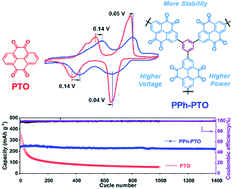An extended carbonyl-rich conjugated polymer cathode for high-capacity lithium-ion batteries†
Abstract
Organic materials have attracted extensive attention for use in lithium-ion batteries due to the flexible designability of their structures and their high theoretical capacities. However, the high solubilities, low voltages, and poor conductivities of traditional organic materials have impeded their further application. Herein, a novel carbonyl-rich covalent organic polymer (COP), polyphenyl-1,3,5-(pyrene-4,5,9,10-tetraone) (PPh-PTO), was designed and synthesized. In situ Fourier-transform infrared spectroscopy (FTIR), ex situ X-ray photoelectron spectroscopy (XPS), and Raman analysis were used to confirm the carbonyl redox-active centers. Moreover, density functional theory (DFT) calculations were used to verify that the extended conjugated structure can induce electron delocalization and achieve an elevated and slanted voltage plateau in comparison with the pyrene-4,5,9,10-tetraone (PTO) monomer. The extended structure enables PPh-PTO to show a high reversible capacity of 235 mA h g−1 at 0.1 A g−1, superior cycling abilities (95% capacity retention after 1400 cycles), and excellent rate performance (94 mA h g−1 at 2 A g−1) in lithium-ion batteries. Our work developed a promising strategy for designing high-energy carbonyl-rich covalent organic polymers for energy storage.

- This article is part of the themed collection: Battery science and technology – powered by chemistry


 Please wait while we load your content...
Please wait while we load your content...